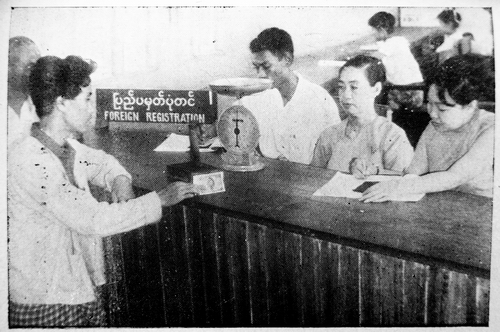
If you’re in Yangon and can’t find a friend or relative to carry a package abroad then there’s always the post office. If you do send something and it doesn’t arrive, U Thein Dan’s Thint-htan-hma kyanut-htan-thoe (сАесАосА╕сАЮсАнсАФсА╣сА╕сАТсАФсА╣сБК сАЮсАДсА╣сА╖сАСсА╢сАЩсА╜ сААсБ╜сА╝сВПсАпсА╣сАХсА╣сАСсА╢сАЮсАнсАпсВФсБК сАЕсАмсА▒сАХсАЧсАнсАЩсАмсАФсА╣сБК сББсБЙсБЗсБГсБК сАЕсАм сББсБЗсББ) or From you to me, is probably not going to give any answers about where it’s gone, but it does contain a lot of other facts on the Myanmar–or at the time he was writing, Burma–post and telegraph office. It is one of the National Library of Australia’s acquisitions in the U Shein Than collection.
The story begins when the service was a privilege of kings and their subordinates, who transmitted royal edicts from Naypyidaw to government representatives via horse and boat. Once the British Empire invaded and occupied lower Burma, it set up new communications, at first for the military, then for trade and diplomacy. In 1862 the imperial government began keeping records of items sent and received, which already numbered hundreds of thousands annually. In 1937, when Burma was administratively separated from India and the territory first issued its own stamps, postal workers handled almost 50 million items.
The Japanese wartime regime put the telegraphs under military control and planned to open new post offices all over the country, but the service deteriorated and ceased operating altogether in March 1945. After the war postal workers joined the independence struggle and went on strike along with other civil servants; following independence, they were unable to work due to widespread insurgency. As fighting waned, more areas became accessible, and the service was gradually restored.
The book has a chapter for philatelists, with photographs of some British and Japanese-era stamps. The author also describes the service of the 1970s, the GPO, what happens to letters without stamps, and reproduces examples of poorly-addressed undelivered items: “Giv to mother near Thaketa gard post” (сАЮсАмсА▒сААсАРсБ┐сАЩсА│сАнсВХ сАВсАРсА╣сАРсА▓сАбсАФсАосА╕ сАбсА▒сАЩсВФсА▒сАХсАХсАл). Apparently a lot of mothers never get their children’s letters, because even in 1973 the dead letter office received around 1500 items daily.
How many does it get now? And where did that parcel go after it was posted from North Okkalapa in 2001? If any New Mandala readers know of a more recent book to answer these or other pressing questions about the mail in Myanmar, please e-mail the details, or if you prefer, send a letter.
[This post is provided by the National Library of Australia as part of our Book Zone feature. For further information on the featured publications contact Nick Cheesman at [email protected]] Facebook
Facebook  Twitter
Twitter  Soundcloud
Soundcloud  Youtube
Youtube  Rss
Rss